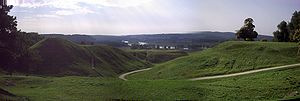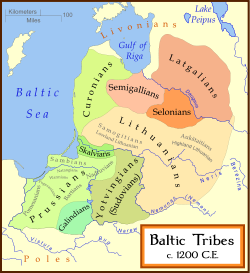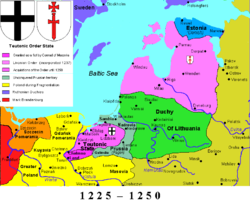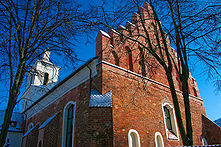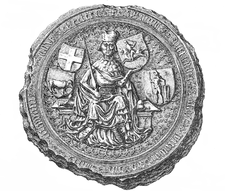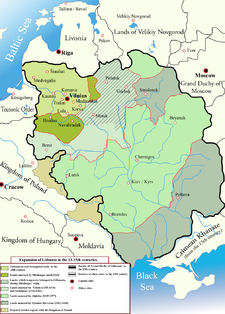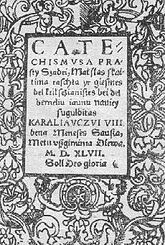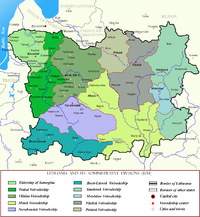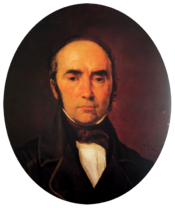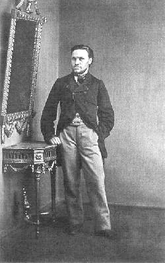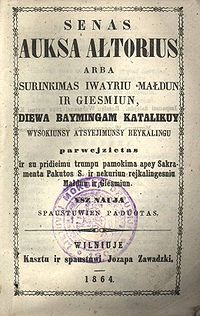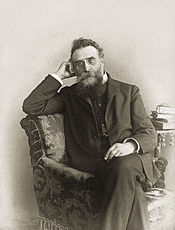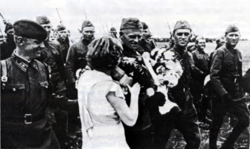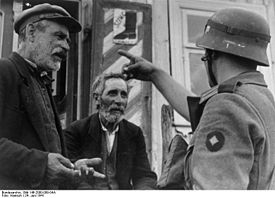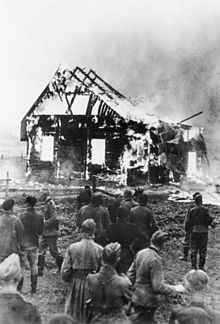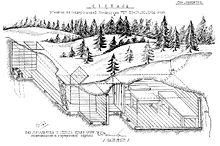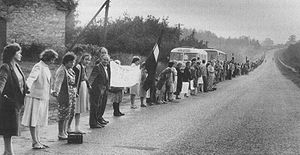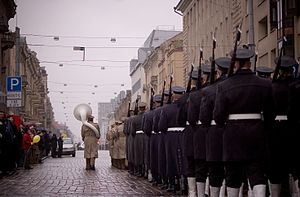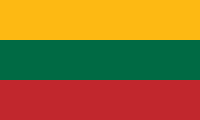- History of Lithuania
-
The history of Lithuania dates back to at least 1009, the first recorded written use of the term.[1] Lithuanians, a branch of the Baltic peoples, later conquered neighboring lands, establishing the Grand Duchy of Lithuania and in the 13th century the short-lived Kingdom of Lithuania. The Grand Duchy was a successful and lasting warrior state. The Duchy remained fiercely independent and was one of the last areas of Europe to adopt Christianity. In the 15th century, Lithuania became the largest state in Europe through the conquest of much of East Slav populated Ruthenia.[2] The Grand Duchy, a formidable power, formed in 1385 a dynastic union with Poland and became Christianized, merging into the Polish–Lithuanian Commonwealth in 1569. In 1795, the Grand Duchy of Lithuania was erased from the political map with the Partitions of the Commonwealth. Afterwards the Lithuanians lived mostly under the rule of the Russian Empire until the 20th century.
On February 16, 1918, Lithuania was reestablished as a democratic state. It remained independent until the outset of World War II, when it was occupied by the Soviet Union under the terms of the Molotov–Ribbentrop Pact. Following a brief occupation by Nazi Germany when the Nazis declared war on the Soviet Union, Lithuania was again absorbed into the Soviet Union for nearly 50 years. In the early 1990s, Lithuania restored its sovereignty and in the following years became integrated into the European political structures.
Before statehood
Early settlement
The first people arrived on the territory of modern Lithuania in the 10th millennium BC after the glaciers had retreated and the last glacial period had ended. According to historian Marija Gimbutas, the people came from two directions: from the Jutland Peninsula and from present-day Poland. They brought two different cultures as evidenced by the tools they used. They were traveling hunters and did not form more stable settlements. In the 8th millennium BC, the climate became much warmer and forests developed. The inhabitants traveled less and engaged in local hunting, gathering and fresh water fishing. During the 6th–5th millennium BC, various animals were domesticated, dwellings became more sophisticated and could shelter larger families. Agriculture did not arrive until the 3rd millennium BC, because of demanding climate and terrain and a lack of suitable tools to cultivate the land. Crafts and trade also started to form at this time. Proto-Indo-Europeans, from whom the Balts later developed, came around 2500 BC.
Baltic tribes
The first Lithuanians were a branch of an ancient group known as the Balts, whose tribes also included the original Prussian and Latvian people. The Baltic tribes were not directly influenced by the Roman Empire, but they did maintain close trade contacts (see Amber Road).
Lithuanians have built a nation that has endured for most of the past ten centuries, while Latvians acquired statehood in the 20th century and Prussian tribes disappeared altogether. The first known reference to Lithuania as a nation ("Litua") comes from the annals of the Monastery of Quedlinburg and is dated March 9, 1009.[3]
Today, the two remaining Baltic nationalities are Lithuanians and Latvians, but there were more Baltic nationalities or tribes in the past. Some of these have merged into the Lithuanians and Latvians (Samogitians, Selonians, Curonians, Semigallians), while others no longer exist (Prussians, Sambians, Skalvians, Galindians).
Formation of Lithuanian state
During the 11th century, Lithuanian territories were included in the list of lands paying tribute to Kievan Rus', but by the 12th century, the Lithuanians were invading neighboring territories themselves. The military and plundering activities of the Lithuanians triggered a struggle for power in Lithuania, which initiated the formation of early statehood, from which the Grand Duchy of Lithuania developed.
Grand Duchy of Lithuania (ca. 1200–1569)
Pagan Lithuania
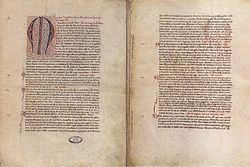 Pope Innocent IV's bull regarding Lithuania's placement under the jurisdiction of the Bishop of Rome, Mindaugas' baptism and coronation
Pope Innocent IV's bull regarding Lithuania's placement under the jurisdiction of the Bishop of Rome, Mindaugas' baptism and coronation
In the early 13th century two German religious orders, the Teutonic Knights and the Livonian Brothers of the Sword, conquered much of the area that is now Estonia and Latvia, in addition to parts of Lithuania. In response, a number of small Baltic tribal groups united under the rule of Mindaugas and soundly defeated the Livonians at Šiauliai in the Battle of Saule in 1236. In 1250 Mindaugas signed an agreement with the Teutonic Order and in 1251 was baptized in their presence by the bishop of Chełmno (in Chełmno Land). On 6 July 1253, Mindaugas was crowned as King of Lithuania and the Kingdom of Lithuania was proclaimed.[4] Mindaugas was murdered in 1263 by his nephew Treniota, which resulted in great unrest and a return to paganism. Pagan Lithuania was a target of Christian crusades of the Teutonic Knights and the Livonian Order. In 1241, 1259 and 1275 the country was ravaged by raids from the Golden Horde.
In 1316, Grand Duke Gediminas, the first of the leaders responsible for Lithuania's great expansion that was to follow,[5] with the aid of colonists from Germany, began restoration of the land. The brothers Vytenis and Gediminas united various groups into one Lithuania.
Gediminas extended the Grand Duchy of Lithuania to the east by challenging the Mongols who, at that time, controlled large areas of Rus'. Through alliances and conquest, in competition with the Grand Duchy of Moscow, the Lithuanians eventually gained control of significant parts (western and southern portions) of the formerly Kievan Rus' territory.[5] This area included most of modern Belarus and Ukraine (the Dnieper River basin) and created a massive Lithuanian state that in the 15th century stretched from the Baltic Sea to the Black Sea.[5]
Gediminas was slain and his son Algirdas suppressed the monasteries. Algirdas took Kiev in 1362 after defeating the Mongols at the Battle of Blue Waters.[5] Algirdas' son, Jogaila, again made overtures to the Teutonic Order and concluded a secret treaty with them. His uncle Kęstutis took him prisoner and a civil war (1381–1384) ensued. Kęstutis was eventually captured, imprisoned and put to death, but Kęstutis's son Vytautas, the future Grand Duke, escaped.
Nowadays Lithuanian paganism is enjoying some revival and is practiced by Ancient Baltic faith community Romuva.
Christian Lithuania, dynastic union with Poland
As the power of Lithuanian warlord dukes expanded to the south and east, the cultivated East Slavic Ruthenians moved in the opposite direction within their new statehood and exerted influence on the Lithuanian ruling class.[6] They brought with them the Old Church Slavonic liturgy of the Eastern Orthodox Christian religion, written Slavic language that was to serve the Lithuanian court's document-producing needs for a few centuries, and developed laws, turning Vilnius into a major center of their civilization.[6] By the time of Jogaila's acceptance of Catholicism at the Union of Krewo in 1385, the establishment of his realm and members of his family had been to a large extent assimilated into the Orthodox Christianity.[6]
Jogaila, a Grand Duke since 1377, was himself still a pagan. He agreed to become a Catholic when offered the Polish crown and the child queen Jadwiga by leading Polish nobles, who were eager to take advantage of Lithuania's expansion. Lithuania's close association with Poland had thus begun, and lasted, in one form or another, for nearly five centuries.[7] For the near future Poland gave Lithuanians a valuable ally against increasing threats from the Teutonic Knights and Muscovy.
Jogaila's baptism and the crowning as the King of Poland in 1386 were followed by the final and official Christianization of Lithuania. After two civil wars Vytautas the Great became the Grand Duke of Lithuania in 1392. During his reign Lithuania reached the peak of its territorial expansion, centralization of the state had begun, and the Lithuanian nobility became increasingly prominent in state politics. The Lithuanian-Polish alliance was able to defeat the mighty Teutonic Knights at the Battle of Grunwald in 1410. The Jagiellon dynasty, founded by Jogaila, ruled Poland and Lithuania continuously until 1572.
The dynastic link to Poland resulted in religious, political and cultural ties and increase of Western influence among the native Lithuanian nobility, and to a lesser extent among the Ruthenian boyars from the East, Lithuanian subjects. The Grand Duchy of Lithuania was preserved as a separate state with separate institutions. Many cities were granted the German system of laws (Magdeburg rights), with the largest of these being Vilnius, since 1322 the capital of the Grand Duchy.
After the deaths of Jogaila and Vytautas, the Lithuanian nobility at times attempted to break the union between Poland and Lithuania, independently selecting Grand Dukes from the Jagiellon dynasty. Lithuania however needed a close alliance with Poland when, at the end of the 15th century, the growing power of the Grand Duchy of Moscow threatened some of Lithuania's Rus' principalities and sparked the Muscovite–Lithuanian Wars and later the Livonian War.
Lithuanian Renaissance
From the 16th to the mid-17th century culture, arts, and education flourished, fueled by the Renaissance and the Protestant Reformation. Francysk Skaryna, who wrote and published in his native Ruthenian (Old Belarusian) language, was typical in this respect of the earlier phase of the Renaissance in the Grand Duchy of Lithuania, which lasted until the middle of the 16th century, when Polish predominated.[8] Many educated Lithuanians came back from studies abroad and the Grand Duchy was boiling with active cultural life, sometimes referred to as Lithuanian Renaissance (not to be confused with Lithuanian National Revival in the 19th century).
At the time Italian architecture was introduced in Lithuanian cities, and Lithuanian literature written in Latin flourished. Also at that time the first handwritten and printed texts in the Lithuanian language emerged, and the formation of written Lithuanian language began. The process was led by Lithuanian scholars Abraomas Kulvietis, Stanislovas Rapalionis, Martynas Mažvydas and Mikalojus Daukša.
Polish–Lithuanian Commonwealth (1569–1795)
Main articles: Polish–Lithuanian Commonwealth, History of Poland (1569–1795), History of the Polish–Lithuanian Commonwealth (1569–1648), History of the Polish–Lithuanian Commonwealth (1648–1764), and History of the Polish–Lithuanian Commonwealth (1764–1795)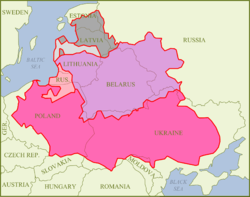 Outline of the Polish–Lithuanian Commonwealth with its major subdivisions as of 1619, superimposed on present-day national borders
Outline of the Polish–Lithuanian Commonwealth with its major subdivisions as of 1619, superimposed on present-day national borders Kingdom of PolandGrand Duchy of LithuaniaDuchy of Courland, joint fief
Kingdom of PolandGrand Duchy of LithuaniaDuchy of Courland, joint fiefWith the Union of Lublin of 1569 Poland and Lithuania formed a new state: the Republic of Both Nations (commonly known as Poland-Lithuania or the Polish–Lithuanian Commonwealth; Polish: Rzeczpospolita Obojga Narodów, Lithuanian: Abiejų Tautų Respublika). The Commonwealth was ruled by Polish and Lithuanian nobility, together with kings, who were elected by the nobles.
Following the union, Polonization increasingly affected all aspects of Lithuanian public life; it took well over a century for the process to be completed. From about 1700 Polish was used in official documents; the Ruthenian language and Latin had been utilized in the Grand Duchy's written transactions prior to that time.[9] Lithuania's ruling families and nobility had become linguistically and culturally Polonized, while retaining a sense of Lithuanian nationality. The Lithuanian language fell into disuse in the circles of the grand dukes' courts in the second half of the 15th century.[10] A century later Polish was commonly used by ordinary Lithuanian nobility.[10] The Lithuanian language however survived, despite the encroachments of the Ruthenian, Polish, Russian, Belarusian and German languages, as a peasant vernacular and from 1547 in written religious use.[11]
 Hetman Kristupas Radvila or Krzysztof Radziwiłł (1585-1640), a Lithuanian Calvinist and an accomplished military commander
Hetman Kristupas Radvila or Krzysztof Radziwiłł (1585-1640), a Lithuanian Calvinist and an accomplished military commander
The predominantly East Slavic population of the territorially expanded Grand Duchy was by and large Eastern Orthodox, and so was the Lithuanian nobility.[12] Unlike the common people of the Lithuanian realm, at about the time of the union with Poland large portion of the Lithuanian state's nobility converted to Western Christianity.[12] Following the Reformation movement many noble families converted to Calvinism in the 1550s and 1560s, and typically a generation later, conforming to the Counter-Reformation trends in the Commonwealth, to Roman Catholicism.[12] In the early Commonwealth religious toleration was the norm and was officially enacted by the Confederation of Warsaw in 1573.[13]
The Union of Lublin and the integration of the two countries notwithstanding, for over two centuries Lithuania continued to exist as the Grand Duchy of Lithuania in the Polish–Lithuanian Commonwealth, retaining separate laws as well as an army and a treasury.[14] At the time of the Union King Sigismund II Augustus removed the Ukrainian territories from Lithuania and incorporated them into the Polish Crown. The Grand Duchy was left with today's Belarus and parts of western Russia, in addition to its Lithuanian ethnic lands.[15] From 1573, the kings of Poland and the grand dukes of Lithuania were always the same person, and were elected by the nobility, who were granted ever increasing liberties and privileges. These liberties, especially the liberum veto, led to political anarchy and the eventual dissolution of the state.
The Commonwealth was greatly weakened by a series of wars, beginning in 1648 with Khmelnytsky's Cossack uprising.[16] During the Northern Wars (1655–1661), the Lithuanian territory and economy were devastated by the Swedish army. Before it could fully recover, Lithuania was again ravaged during the Great Northern War (1700–1721). The war, plague, and famine resulted in the loss of approximately 40% of the country's inhabitants.[17] Foreign powers, especially Russia, became dominant players in the domestic politics of the Commonwealth. Numerous factions among the nobility used their "Golden Liberty" to prevent any reforms.
The Constitution of May 3, 1791, a culmination of the belated reform process of the Commonwealth, was passed by the Sejm (central legislature). It attempted to integrate Lithuania and Poland more closely, although the separation was kept by the added Reciprocal Guarantee of Two Nations. Partitions of the Polish–Lithuanian Commonwealth in 1772, 1793 and 1795 terminated the existence of the Commonwealth and saw Lithuania divided between Russia and Prussia. Lithuania ceased to exist as a distinct entity for more than a century.
Under Imperial Russia, World War I (1795–1918)
Post-Commonwealth Lithuania 1795–1864; foundations of Lithuanian nationalism
Following the partitions of the Polish Lithuanian Commonwealth, the Russian Empire controlled the majority of Lithuania, including Vilnius, which was a part of the Vilna Governorate. In 1803 Emperor Alexander I revived and upgraded the old Jesuit academy as the imperial Vilnius University, the largest in the Russian Empire. The university and the regional educational system was directed on behalf of the Tsar by Prince Adam Czartoryski.[18] In the early years of the 19th century, there were signs that Lithuania might be allowed some separate recognition by the Empire, however this had never happened.
These hopes were soon to be dashed, particularly subsequent to 1812, when Lithuanians eagerly welcomed Napoleon Bonaparte's French army as liberators, with many joining his offensive against Russia. After the French army's defeat and withdrawal, Tsar Alexander I decided to keep the University of Vilnius open and the poet Adam Mickiewicz was able to receive his education there.[19] The south-western part of Lithuania included in Prussia in 1795 and in the short-lived Duchy of Warsaw in 1807 became a part of the Russian-controlled Kingdom of Poland in 1815, while the rest of Lithuania continued to be administered as a Russian province.
Lithuanians and Poles revolted twice, in 1831 and 1863, but both attempts had failed and resulted in increased repression by the Russian authorities. After the November Uprising, Tsar Nicholas I began an intensive program of Russification and the University of Vilnius was closed.[20]
The poetry of Adam Mickiewicz, emotionally attached to the Lithuanian setting and exploring Lithuania's medieval themes, influenced ideological foundations of the emerging Lithuanian national movement. Simonas Daukantas, who studied with Mickiewicz at Vilnius, promoted a return to Lithuania's pre-Commonwealth traditions and a renewal of the local culture, based on the Lithuanian language. With those ideas in mind he wrote already in 1822 (at that time not published) a history of Lithuania in Lithuanian. Teodor Narbutt wrote in Polish a voluminous Ancient History of the Lithuanian Nation (1835–1841), where he likewise expounded and expanded further the concept of historic Lithuania, whose days of glory had ended with the union with Poland (1569). Narbutt, invoking the German scholarship, pointed out the relationship between the Lithuanian and Sanskrit languages. It indicated the closeness of Lithuanian (preserved in considerable isolation from historic era foreign influences) to its old Indo-European roots and would later provide the "antiquity" argument for the national revival activists. By the middle of the 19th century the basic ideology of the future nationalist movement had thus been defined; it required, in order to establish a modern Lithuanian identity, a break with the Polish (early modern) tradition and cultural-linguistic dependence.[21]
Around the time of the January Uprising, there was a generation of Lithuanian leaders of the transitional period, between the Grand Duchy-oriented, bound with Poland, and the modern nationalist Lithuanian language-based movement. Jakób Gieysztor, Konstanty Kalinowski and Antanas Mackevičius wanted to form alliances with the local (Lithuanian and Belarusian speaking) peasants, who, empowered and given land, would presumably help defeat the Russian Empire, acting in their own self-interest. This created new dilemmas that had to do with languages used for such inter-class communication, and later led to the concept of a nation as the "sum of speakers of a vernacular tongue".[22]
Formation of modern national identity and push for self-rule 1864–1918
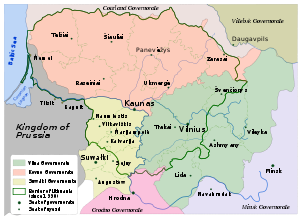 Modern Lithuania with the former Russian Empire's administrative divisions (governorates) shown (1867–1914)
Modern Lithuania with the former Russian Empire's administrative divisions (governorates) shown (1867–1914)
The 1864 failure of the January Uprising made on the one hand the Polish connection seem of no further practical use to Lithuanians, while on the other led to the creation of a class of emancipated and even prosperous Lithuanian peasants, custodians of the Lithuanian language. Educational opportunities, now more widely available also to young people of such common origins, were one of the crucial factors responsible for the Lithuanian revival. As schools were being de-Polonized and Lithuanian university students sent to St. Petersburg or Moscow rather than Warsaw, a cultural void resulted and it was not being successfully filled by the attempted Russification policies. In the following decades, a national movement emerged. It was composed of activists of different social backgrounds and persuasions, often primarily Polish speaking, but united by their willingness and zeal to promote the Lithuanian culture and language as a strategy for building a modern nation.[23]
In 1864 the Lithuanian language and the Latin alphabet were banned in junior schools. Lithuanians resisted the Russification by arranging printing abroad and smuggling the books in by knygnešiai. The tsarist authorities implemented a number of Russification policies, including a ban on Lithuanian press and the closing of cultural and educational institutions, and Lithuania became part of a new administrative region called Northwestern Krai.
Because many Lithuanian nobles were Polonized and only the poor and middle classes used Lithuanian (some of the latter also preferred to use Polish), Lithuanian was not considered a prestigious language. There were even expectations that the language would become extinct, as more and more territories in the east were Slavicized, and more people used Polish or Russian in daily life. The only place where Lithuanian was considered more prestigious and worthy of books and studying was German-controlled Lithuania Minor. Even there, an influx of German immigrants threatened the native language and culture.
The language was already present among poor people and the language revival spread into more affluent strata, beginning with the release of Lithuanian newspapers, Aušra and Varpas, then with the writing of poems and books in Lithuanian. These writings glorified the Grand Duchy of Lithuania, depicting the historic nation of great power and with many heroes.
The two most prominent figures in the revival movement, Jonas Basanavičius and Vincas Kudirka, both originated from affluent Lithuanian peasantry and both attended the Marijampolė (Mariampol) secondary school in the Suvalkai region, where serfdom had been eliminated in 1807, the time of Napoleon's takeover. The school was a Polish educational center, Russified after the Uprising, with the Lithuanian language classes introduced at that time.[24]
Basanavičius studied medicine at Moscow, where he developed international connections, published in Polish on Lithuanian history and graduated in 1879. From there he went to Bulgaria, and in 1882 moved to Prague. In Prague he met and became influenced by the Czech national movement activists. In 1883 Basanavičius began working on a Lithuanian language review, which assumed the form of a newspaper named Aušra (The Dawn). Published abroad, Aušra was written in the Latin script, banned under the Russian rule where Cyrillic characters were required for printing in Lithuanian, and was smuggled to Lithuania. The review (forty issues in total), building on the work of the earlier writers, sought to establish continuities with the medieval Grand Duchy of Lithuania and exalted the Lithuanian common people in their role as the conduit of that (essential for the national revival) continuity.[25]
Russian restrictions at Marijampolė secondary school were eased in 1872 and Kudirka, enrolled at that time, learned Polish there. He went on to study at the Warsaw imperial university, where he was influenced by Polish socialists. In 1889 Kudirka returned to Lithuania and worked on incorporating Lithuanian peasantry into mainstream politics, as the main building block of a modern nation. In 1898 he wrote a poem inspired by the opening strophe of Mickiewicz's masterpiece Pan Tadeusz, using the poet's famous invocation in a different language and for a differently understood, but resonating with the patriotism of the original, national purpose. The poem became the national anthem of Lithuania (Tautiška Giesmė).[26]
The revival spearheaded the independence movement, with various organizations opposing Russian influence. Russian policy became harsher in response. Attacks took place against Catholic churches while a ban forbidding Lithuanian press continued.
The period from 1890 to 1904 saw the publication of about 2,500 book titles in the Lithuanian Latin alphabet. The majority of these were published in Tilsit, a city in East Prussia, although some publications reached Lithuania from the United States. A largely standardized written version of the language was achieved by the turn of the twentieth century, based on historical and Aukštaitijan (highland) usages.[27] The letters -č-, -š- and -v- were taken from the modern (redesigned) Czech orthography, to avoid the Polish usage for corresponding sounds.[28][29] The widely-accepted Lithuanian Grammar, by Jonas Jablonskis, appeared in 1901.[28]
In 1879 Emperor Alexander II of Russia approved a proposal from the Russian military leadership to build the largest defensive structure in the entire Russian state – the 65 km2 (25 sq mi) Kaunas Fortress.[30] Large numbers of Lithuanians went to the United States in 1867–1868 after a famine in Lithuania.[31] Between 1868 and 1914, approximately 635,000 people, almost 20% of the population, left Lithuania.[32] Nevertheless, a Lithuanian National Revival laid the foundations of the modern Lithuanian nation and independent Lithuania.
Lithuania's nationalist movement continued to grow. During the Russia-wide revolutionary uprising of 1905, a congress of Lithuanian representatives in Vilnius known as the Great Seimas of Vilnius demanded provincial autonomy on 5 December of that year. The tsarist regime made a number of concessions as the result of the 1905 uprising. The Baltic states could once again use their native languages in schooling and public discourse. The Latin script replaced the Cyrillic script which had been forced upon Lithuanians for four decades. However, not even Russian liberals were prepared to concede autonomy similar to that that had already existed in Estonia and Latvia, albeit under Baltic German hegemony.[33]
Under Otto von Bismarck, the German policy had corresponded to that of tsarist Russia, along the lines of Prussian alliances extending back to the Napoleonic era (both powers acting together against Poland). While many Baltic Germans looked toward aligning the Baltics (Lithuania and Courland in particular) with Germany, they had taken no overt action. However, after the outbreak of hostilities in World War I Germany occupied Lithuania and Courland in 1915. An alliance with Germany in opposition to both tsarist Russia and Lithuanian nationalism became for the Baltic Germans a real possibility.[33]
Independent Lithuania (1918–1940)
Declaration of independence
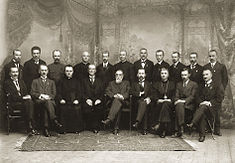 The original 20 members of the Council of Lithuania after signing the Act of Independence of Lithuania, 16 February 1918
The original 20 members of the Council of Lithuania after signing the Act of Independence of Lithuania, 16 February 1918
During World War I Lithuania was incorporated into Ober Ost, occupational German government. As the war progressed, it became evident that Germany would not reach an effective victory and would have to compromise with the Russian Empire.[34] As open annexation could result in a public relations backlash, the Germans planned to form a network of formally independent states that would in fact be completely dependent on Germany, the so-called Mitteleuropa.[35] The Germans allowed the Vilnius Conference (September 18–22, 1917) to convene, demanding that Lithuanians declare loyalty to Germany and agree to an annexation. The Conference elected a 20-member Council of Lithuania and empowered it to act as the executive authority of the Lithuanian people.[35] The Council adopted the Act of Independence of Lithuania on February 16, 1918. It declared Lithuania as an independent republic, organized according to democratic principles. The Germans, still present in the country, did not support such a declaration and hindered any attempts to establish the proclaimed independence. To prevent being incorporated into the German Empire, Lithuanians elected Monaco-born King Mindaugas II as the titular monarch of the Kingdom of Lithuania in July 1918. Mindaugas II never assumed the throne.
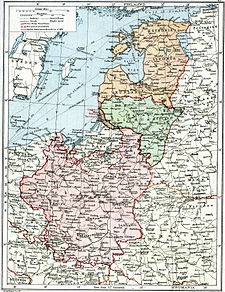 Lithuania and Poland after the treaties of Versailles and Brest-Litovsk and before the Peace of Riga
Lithuania and Poland after the treaties of Versailles and Brest-Litovsk and before the Peace of Riga
Germany lost the war and signed the Armistice of Compiègne on November 11, 1918. Lithuanians quickly formed their first government, led by Augustinas Voldemaras, adopted a provisional constitution, and started organizing basic administrative structures. As the defeated German army was withdrawing from the Eastern Front, it was followed by the Soviet forces, whose intention was to spread the global proletarian revolution. They created a number of puppet states, including the Lithuanian Soviet Socialist Republic. By the end of December the Red Army reached Lithuanian borders, starting the Lithuanian–Soviet War. The Lithuanian government evacuated from Vilnius to Kaunas, the temporary capital of Lithuania. Vilnius was captured on January 5, 1919. As the Lithuanian army was in its infant stages, the Soviet forces moved largely unopposed and by mid-January 1919 controlled about ⅔ of the Lithuanian territory. From April 1919 the Lithuanian war went parallel with the Polish–Soviet War. Poland had territorial claims over Lithuania, especially the Vilnius Region, and these tensions spilled over into the Polish–Lithuanian War. In mid-May the Lithuanian army, commanded by General Silvestras Žukauskas, began an offensive against the Soviets in northeastern Lithuania. By the end of August 1919, the Soviets were pushed out of the Lithuanian territory. When the Soviets were defeated, Lithuanian army was deployed against the paramilitary West Russian Volunteer Army, who invaded northern Lithuania. They were rouse German and Russian soldiers who sought to retain German control over the former Ober Ost. West Russian Volunteers were defeated and pushed out by the end of 1919. Thus the first phase of the Lithuanian Wars of Independence was over and Lithuanians could direct attention to internal affairs.
Democratic Lithuania
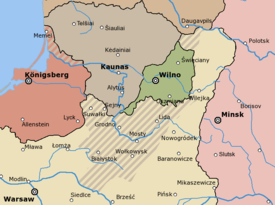 Lithuanian-Polish territorial disputes in the early 1920s: the "Republic of Central Lithuania" (green)
Lithuanian-Polish territorial disputes in the early 1920s: the "Republic of Central Lithuania" (green)
The Constituent Assembly of Lithuania was elected in April and first met in May 1920. In June it adopted the third provisional constitution and in July signed the Soviet–Lithuanian Peace Treaty. In the treaty the Soviet Union recognized fully independent Lithuania and its claims to the disputed Vilnius Region. The treaty increased hostilities between Poland and Lithuania. To prevent further fighting, the Suwałki Agreement was signed in October. But before it went into effect, Polish General Lucjan Żeligowski staged a military action presented as a mutiny, invaded Lithuania, captured Vilnius, and established a short-lived Republic of Central Lithuania. For 19 years Kaunas became the temporary capital of Lithuania. The League of Nations attempted to mediate the dispute and Paul Hymans proposed plans of a Polish–Lithuanian union. However, the negotiations broke down as neither side agreed to the compromise. The Central Lithuania held a plebiscite and was incorporated into Poland in March 1922. The Vilnius Region dispute was not resolved. Lithuania broke all relations with Poland refusing to recognize, even de facto, its control over Vilnius, the historical capital of Lithuania with at that time largely Polish-speaking population.[36] The dispute continued to dominate Lithuanian foreign policy and doomed the relations with Poland for the entire interwar period.
The Constituent Assembly, which adjourned in October 1920 due to threats from Poland, gathered again and initiated many reforms needed in the new state: obtained international recognition and membership in the League of Nations, passed the law of land reform, introduced national currency litas, and adopted the final constitution in August 1922. Lithuania became a democratic state, with Seimas (parliament) elected by men and women for a three-year term. The Seimas elected the president. The First Seimas was elected in October 1922, but could not form a government as the votes split equally 38–38 and was forced to resign. Its only lasting achievement was the Klaipėda Revolt in January 1923. Lithuania took advantage of the Ruhr Crisis and captured the Klaipėda Region, a territory detached from East Prussia according to the Treaty of Versailles, and placed under French administration. The region was incorporated as an autonomous district of Lithuania in May 1924. For Lithuania it was the only access to the Baltic Sea and an important industrial center. The Revolt was the last armed conflict in Lithuania before World War II. The Second Seimas, elected in May 1923, was the only Seimas in independent Lithuania that served the full term. The Seimas continued the land reform, introduced social support systems, started repaying foreign debt. Strides were made in education: the network of primary and secondary schools was expanded and first universities were established in Kaunas. A national census took place in 1923.
Authoritarian Lithuania
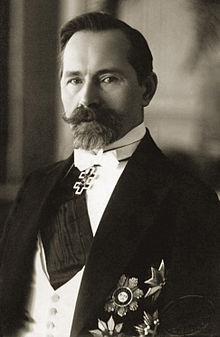 Antanas Smetona, the first and last president of independent Lithuania during the interbellum. The 1918–1939 period if often known as "Smetona's time".
Antanas Smetona, the first and last president of independent Lithuania during the interbellum. The 1918–1939 period if often known as "Smetona's time".
The Third Seimas was elected in May 1926. For the first time Lithuanian Christian Democrats (krikdemai) lost their majority and became an opposition. It was sharply criticized for signing the Soviet–Lithuanian Non-Aggression Pact and accused of "Bolshevization" of Lithuania. As a result of growing tensions, the government was deposed during the 1926 Lithuanian coup d'état in December. The coup, organized by the military, was supported by the Lithuanian Nationalists Union (tautininkai) and Lithuanian Christian Democrats. They installed Antanas Smetona as the President and Augustinas Voldemaras as the Prime Minister.[37] Smetona suppressed the opposition and remained as an authoritarian leader until June 1940.
The Seimas thought that the coup was just a temporary measure and new elections should be called to return Lithuania to democracy. The legislative body was dissolved in May 1927. Later that year members of the Social Democrats and other leftist parties, named plečkaitininkai after their leader, tried to organize an uprising against Smetona but were quickly subdued. Voldemaras grew increasingly independent of Smetona and was forced to resign in 1929. Three times in 1930 and once in 1934 he unsuccessfully attempted to return to power. In May 1928 Smetona, without the Seimas, announced the fifth provisional constitution. It continued to claim that Lithuania is a democratic state and vastly increased powers of the President. His party, the Lithuanian National Union, steadily grew in size and importance. Smetona adopted the title of "tautos vadas" (leader of the nation) and slowly started building personality cult. Many of the prominent political figures married into Smetona's family (Juozas Tūbelis, Stasys Raštikis).
When the Nazi Party came into power in the Weimar Republic, Germany–Lithuania relations worsened considerably as Nazi Germany did not accept the loss of the Klaipėda Region. The Nazis sponsored anti-Lithuanian organizations in the region. In 1934, Lithuania put the activists on trial and sentenced about 100 people, including their leaders Ernst Neumann and Theodor von Sass. That prompted Germany, one of the main trade partners of Lithuania, to declare embargo of Lithuanian products. In response Lithuania shifted its exports to Great Britain. But that was not enough and peasants in Suvalkija organized strikes, which were violently suppressed. Smetona's prestige was damaged and in September 1936 he agreed to call the first elections to Seimas since the coup of 1926. Before the elections all political parties, except the National Union, were eliminated. Thus of the 49 members of the Fourth Seimas, 42 were from the National Union. It functioned as an advisory board to the President and in February 1938 adopted a new constitution, which granted the President even greater powers.
As tensions were rising in Europe following the annexation of Austria by Nazi Germany, Poland presented an ultimatum to Lithuania in March 1938. Poland demanded the re-establishment of normal diplomatic relations, which were broken after the Żeligowski's Mutiny in 1920, and threatened military actions in case of refusal. Lithuania, having a weaker military and unable to enlist international support for its cause, accepted the ultimatum. Lithuania–Poland relations somewhat normalized and the parties concluded treaties regarding railway transport, postal exchange, and other means of communication. Just a year after the Polish ultimatum and five days after the German occupation of Czechoslovakia, Lithuania received as oral ultimatum from Joachim von Ribbentrop demanding to cede the Klaipėda Region to Germany. Again, Lithuania was forced to accept. This triggered a political crisis in Lithuania and forced Smetona to form a new government which for the first time since 1926 included members of the opposition. The loss of Klaipėda was a major blow to Lithuanian economy and the country shifted to the sphere of German influence. When Germany and the Soviet Union concluded the Molotov–Ribbentrop Pact in 1939 and divided Eastern Europe into spheres of influence, Lithuania was, at first, assigned to Germany.
World War II (1939–1945)
First Soviet occupation
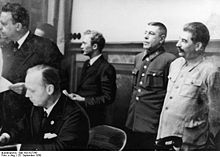 Joseph Stalin, Joachim von Ribbentrop and others at the signing of the German–Soviet Boundary and Friendship Treaty
Joseph Stalin, Joachim von Ribbentrop and others at the signing of the German–Soviet Boundary and Friendship Treaty
In August 1939, Nazi Germany and the Soviet Union signed the Molotov–Ribbentrop Pact, with secret clauses assigning spheres of influence in the area of the Baltic Sea. Lithuania, initially assigned to the German sphere of influence, was transferred to the Soviets in secret additional protocols of the German–Soviet Boundary and Friendship Treaty of September 28, 1939. The city of Vilnius, regarded by Lithuanians as their capital, but under Polish control before the war, was occupied by the Red Army during the invasion of Poland. Soviet-proposed Soviet–Lithuanian Mutual Assistance Pact transferred one fifth of the Vilnius Region (including Vilnius) to Lithuanian control in exchange for the stationing of 20,000 Soviet troops within Lithuania.
Once the Winter War in Finland was over and Germany was making rapid advances against Denmark and Norway and against France and the Low Countries, the Soviets heightened their diplomatic pressure on Lithuania, culminating in the Soviet ultimatum to Lithuania of June 1940. The ultimatum demanded the formation a new pro-Soviet government and admission of an unspecified number of Russian troops. Lithuania accepted the ultimatum as effective military resistance was impossible with Soviet troops already within the country according to the Mutual Assistance Pact. President Antanas Smetona left Lithuania as the Soviet military forces (15 divisions with 150,000 soldiers) crossed the Lithuanian border on June 15, 1940. As the Soviet Union occupied and annexed Lithuania in accordance with the Molotov–Ribbentrop Pact,[38][39] Lithuania lost its independence.
Soviet representative Vladimir Dekanozov formed the new pro-Soviet puppet government, known as the People's Government. Justas Paleckis replaced Smetona as the acting President of Lithuania. The new government was a rubber stamp institution, carrying out orders from Moscow. The Fourth Seimas was disbanded and new show elections to the so-called People's Seimas were organized on July 14–15, 1940. With only Communist-approved candidates running, official results showed over 90% of voter turnout and support for the Communists. During its first session on July 21 the People's Seimas unanimously decided to convert Lithuania into the Lithuanian SSR and petition to join the Soviet Union. The petition was approved by the Supreme Soviet of the Soviet Union on August 3, which completed the formalization of the occupation.
Immediately following the occupation, Soviet authorities began rapid Sovietization of Lithuania. All land was nationalized. To gain support for the new regime among the poorer peasants, large farms were distributed to small landowners. However, in preparation for eventual collectivization, agricultural taxes were dramatically increased in an attempt to bankrupt all farmers. Nationalization of banks, larger enterprises, and real estate resulted in disruptions in production causing massive shortages of goods. The Lithuanian litas was artificially undervalued and withdrawn by spring 1941. The standard of living plummeted. All religious, cultural, and political organizations were banned leaving only the Communist Party of Lithuania and its youth branch. Estimated 12,000 "enemies of the people" were arrested. During the June deportation some 17,000 people (mostly former military officers, policemen, political figures, intelligentsia and their families) were deported to Gulags in Siberia, where many perished due to inhumane conditions.
Nazi occupation
Collaboration and resistance
On June 22, 1941, Nazi Germany invaded the Soviet Union. The German forces moved rapidly, encountering only sporadic Soviet resistance and within a week controlled entire Lithuania. The retreating Soviet forces massacred Lithuanian political prisoners (see Rainiai massacre). The Lithuanians generally greeted the Germans as liberators from the oppressive Soviet regime and hoped that Germany would restore some autonomy to Lithuania. The Lithuanian Activist Front organized anti-Soviet June Uprising, declared independence, and formed the Provisional Government of Lithuania with Juozas Ambrazevičius as Prime Minister. The Provisional Government was not forcibly dissolved, but stripped of any actual power it resigned on August 7, 1941. The Germans established the civil administration, known as the Reichskommissariat Ostland. The Germans did not have enough manpower to staff local administration; therefore, most local offices were headed by the Lithuanians. Policy decisions would be made by high-ranking Germans and actually implemented by low-ranking Lithuanians. Overall, local self-government was quite developed in Lithuania and helped to sabotage or hinder several German initiatives, including raising a Waffen-SS unit or providing men for forced labor in Germany.
There was substantial cooperation and collaboration between the German forces and some Lithuanians. The Lithuanian Activist Front volunteered a police force, known as Tautinio Darbo Apsaugos Batalionas (TDA), hoping that it would be later transformed into regular army of independent Lithuania. Instead these units were employed by the Germans as auxiliary in massacres of the Jews during the Holocaust. Another infamous unit was the Lithuanian Security Police (Saugumo policija) operating in Vilnius. A number of other police battalions were formed; the auxiliary forces were sometimes employed outside of Lithuania and charged with securing communications, guarding prisoners, delivering supplies, etc. Harsh German policies of settling ethnic Germans in Lithuania, collecting large war provisions, gathering people for forced labor, conscripting men into the German army etc. soon produced a resistance movement. The most notable resistance organization, the Supreme Committee for the Liberation of Lithuania, was formed in 1943. Despite German pressure a Waffen-SS division was not established in Lithuania. Eventually, the Lithuanian general Povilas Plechavičius agreed to form the Lithuanian Territorial Defense Force (LTDF), which was to operate solely in the Lithuanian territory and be commanded by Lithuanian officers. When Germans did not honor the agreement and attempted to subordinate LTDF to the German army, Plechavičius disbanded it in May 1944.
Lithuanians also organized armed resistance, which was conducted by pro-Soviet partisans, operated in eastern Lithuania, and mainly consisted of minority Russians, Belarusians and Jews. This group fought for the re-incorporation of Lithuania into the Soviet Union. Soviet partisans committed a number of atrocities (for example, the Koniuchy massacre) and sacked towns and villages.[40] The villagers were forced to organize local self-defense. The Polish Armia Krajowa (AK) also operated in eastern Lithuania, expecting post-war Poland to resume control of the Vilnius Region. AK was fighting not only against the Nazis, but also against the pro-Nazi Lithuanian police, Lithuanian Territorial Defense Force, and the Soviet partisans. Relationships between different guerrilla detachments were never cordial and worsened as the war went on.
The Holocaust
Main article: The Holocaust in LithuaniaBefore the Holocaust, Lithuania was home to about 210,000[41] or 250,000[42] Jews. According to one estimate, the Nazis and their Lithuanian collaborators murdered around 190,000 Lithuanian Jews (91% of the pre-war Jewish community) during the Holocaust.[43] The Holocaust in Lithuania can be divided into three stages: mass executions (June–December 1941), ghetto period (1942 – March 1943), and final liquidation (April 1943 – July 1944). Unlike in other Nazi-occupied countries where the Holocaust was introduced gradually, Einsatzgruppe A started executions in Lithuania on the first days of war. The executions were carried out by three main groups: in Kaunas (Ninth Fort), in Vilnius (Ponary massacre), and in the countryside (Rollkommando Hamann). Estimated 80% of Lithuanian Jews were killed before 1942.[44] The surviving 43,000 Jews were concentrated in the Vilnius, Kaunas, Šiauliai, and Švenčionys ghettos and forced to work for the benefit of German military industry. On June 21, 1943, Heinrich Himmler issued order to liquidate all ghettos and transfer remaining Jews to concentration camps. Vilnius Ghetto was liquidated, while Kaunas and Šiauliai were turned into concentration camps and existed until July 1944.[45] Remaining Jews were sent to camps in Stutthof, Dachau and Auschwitz. Only about 2,000–3,000 Lithuanian Jews were liberated from these camps.[45] More survived by withdrawing into the interior of Russia before the war broke out or by escaping the ghettos and joining the Jewish partisans. The genocide rate of Jews in Lithuania, up to 95–97%, was one of the highest in Europe. This was primarily due, with few notable exceptions, to widespread Lithuanian cooperation with the German authorities. Jews were widely considered to be responsible for the previous Soviet regime (see Jewish Bolshevism) and were resented for welcoming Soviet troops.[46] There was also resistance to the German occupation, and some Lithuanians risked their own lives to save Jews; 723 Lithuanians are recognized as Righteous among the Nations for their efforts.
Return of Soviet authority
Main article: Occupation and annexation of the Baltic states by the Soviet Union (1944)In the summer of 1944, the Red Army reached eastern Lithuania, while the city of Vilnius was captured by the Polish Armia Krajowa during the ill-fated Operation Ostra Brama. The USSR re-occupied Lithuania and the Soviets re-established the Lithuanian Soviet Socialist Republic in 1944, with the passive agreement of the United States and Britain (see Yalta Conference and Potsdam Agreements). By January 1945, the Soviets captured Klaipėda, on the Baltic coast. It is estimated that Lithuania lost 780,000 people during World War II.[47]
Soviet Lithuania (1944–1990)
Main article: Baltic states under Soviet rule (1944–1991)Stalinism and Soviet rule (1944–1988)
The mass deportation campaigns of 1941–1952, the June deportation according to Serov Instructions and the March deportation known as Operation "Priboi", exiled tens of thousands of families to forced settlements in Siberia and other remote parts of the Soviet Union. Official statistics[citation needed] state that more than 120,000 people were deported from Lithuania during this period, while researchers estimate the number of political prisoners and deportees at 300,000. In response to these events, approximately 100,000 of local organized resistance fighters participated in unsuccessful partisan warfare against the Soviet regime from 1944 to 1952. An estimated 30,000 partisans and their supporters were killed and many more were arrested and deported to Siberian gulags. The last partisan was killed in combat in 1965. Soviet authorities encouraged immigration of non-Lithuanian workers, especially Russians, as a way of integrating Lithuania into the Soviet Union and to encourage industrial development. This period is memorialized in Grūtas Park.
Rebirth (1988–1990)
Until mid-1988, all political, economic, and cultural life was controlled by the Lithuanian Communist Party (LCP). Lithuanians as well as people in two other Baltic republics distrusted the Soviet regime even more than people in other regions of the Soviet state, and gave their own specific and active support to Mikhail Gorbachev's program of social and political reforms known as perestroika and glasnost. Under the leadership of intellectuals, the Lithuanian reform movement "Lietuvos persitvarkymo sąjūdis" (the Reform Movement of Lithuania) was formed in mid-1988 and declared a program of democratic and national rights, winning nationwide popularity. Inspired by Sąjūdis, the Lithuanian Supreme Soviet passed constitutional amendments on the supremacy of Lithuanian laws over Soviet legislation, annulled the 1940 decisions on proclaiming Lithuania a part of the USSR, legalized a multi-party system, and adopted a number of other important decisions, including the return of the national state symbols — the flag and the anthem. A large number of LCP members also supported the ideas of Sąjūdis, and with Sąjūdis support, Algirdas Brazauskas was elected First Secretary of the Central Committee of the LCP in 1988. On 23 August 1989, 50 years after the Molotov–Ribbentrop Pact, in order to draw the world's attention to the fate of the Baltic nations, Latvians, Lithuanians and Estonians joined hands in a human chain that stretched 600 kilometres from Tallinn, to Riga, to Vilnius. The human chain was called the Baltic Way. In December 1989, the Brazauskas-led LCP declared its independence from the Communist Party of the Soviet Union and became a separate party, renaming itself in 1990 the Democratic Labour Party of Lithuania.
Independent modern Lithuania (1990–present)
Struggle for independence (1990–1991)
In early 1990, Sąjūdis-backed candidates won the elections to the Lithuanian Supreme Soviet.[48] On March 11, 1990, the Supreme Soviet proclaimed the re-establishment of Lithuanian independence. The Baltic republics were in the forefront of the struggle for independence and Lithuania was the first of the Soviet republics to declare independence. Vytautas Landsbergis became the head of the state and Kazimira Prunskienė led the Cabinet of Ministers. On March 15, the Soviet Union demanded revocation of the independence and began employing political and economic sanctions against Lithuania. Soviet military was used to seize a few public buildings, but violence was largely contained until January 1991. During the January Events, the Soviet authorities attempted to overthrow the elected government by sponsoring the so-called National Salvation Committee. The Soviets forcibly took over the Vilnius TV Tower, killing 14 unarmed civilians and injuring 700.[49] Moscow failed to act further to crush the Lithuanian independence movement and the Lithuanian government continued to work.
During the national referendum on February 9, 1991, more than 90% of those who took part in the voting (76% of all eligible voters) voted in favor of an independent, democratic Lithuania. During the August Coup in Moscow, Soviet military troops took over several communications and other government facilities in Vilnius and other cities, but returned to their barracks when the coup failed. The Lithuanian government banned the Communist Party and ordered confiscation of its property. Following the failed coup, Lithuania received widespread international recognition and was admitted to the United Nations.
Contemporary Republic of Lithuania (1991–present)
As in many other formerly Soviet countries, popularity of the independence movement (Sąjūdis in the case of Lithuania) was diminishing due to worsening economic situation (rising unemployment, inflation, etc.). The Lithuanian Communist Party renamed itself Democratic Labour Party of Lithuania (LDDP) and ran against Sąjūdis in the 1992 parliamentary elections, gaining a majority of the seats. LDDP continued building the independent democratic state and transitioning from a centrally planned to a free market economy. In the 1996 parliamentary elections, the voters swinged back to the rightist Homeland Union, led by the former Sąjūdis leader Vytautas Landsbergis.
As part of the transition to a free market economy, Lithuania organized a privatization campaign to sell government-owned residential real estate and commercial enterprises. The government issued investment vouchers to be used in privatization instead of actual currency. People cooperated in groups to collect larger amounts of vouchers for the public auctions and the privatization campaign. Lithuania, unlike Russia, did not create a small group of very wealthy and powerful people. The privatization started with small organizations, and large enterprises (such as telecoms or airlines) were sold several years later for hard currency in a bid to attract foreign investors. Lithuania's monetary system was to be based on litas, the currency used during the interwar period. Due to high inflation and other delays a temporary currency, talonas, was introduced (commonly called Vagnorkė or Vagnorėlis after Prime Minister Gediminas Vagnorius). Eventually litas was issued in June 1993 and it was decided to peg it to the United States dollar in 1994 and to the Euro in 2002.
Despite Lithuania's achievement of complete independence, sizable numbers of Russian forces remained in its territory. Withdrawal of those forces was one of Lithuania's top foreign policy priorities. Russian troop withdrawal was completed by August 31, 1993. The first military of the reborn country were the Volunteer Forces, who first took an oath at the Supreme Council of Lithuania soon after the independence declaration. The Lithuanian military built itself to the common standard with an air force, navy and land army. Interwar paramilitary organisations such as Lithuanian Riflemen's Union, Young Riflemen, and Lithuanian Scouts were reestablished. Seeking closer ties with the West, Lithuania applied for the North Atlantic Treaty Organization (NATO) membership in 1994. The country had to go through a difficult transition from a planned economy to a free market one, satisfying the requirements for the European Union (EU) membership.
In October 2002, Lithuania was invited to join the European Union and one month later to join the North Atlantic Treaty Organization; it became a member of both in 2004.
See also
- Dissolution of the Soviet Union
- History of Belarus
- History of Estonia
- History of Europe
- History of European Union
- History of Germany
- History of Latvia
- History of Russia
- History of Poland
- List of Presidents of Lithuania
- Prime Minister of Lithuania
- Politics of Lithuania
References
- ^ Gudavičius, Edvardas (1999) Lietuvos Istorija: Nuo Seniausių Laikų iki 1569 Metų (Lithuanian History: From Ancient Times to the Year 1569) Vilnius, page 28, ISBN 5-420-00723-1
- ^ R. Bideleux. A History of Eastern Europe: Crisis and Change. Routledge, 1998. p.122
- ^ Baranauskas, Tomas (Fall 2009). "On the Origin of the Name of Lithuania". Lithuanian Quarterly Journal of Arts and Sciences 55 (3). ISSN 0024-5089.
- ^ (Lithuanian) Tomas Baranauskas. Lietuvos karalystei – 750. 2001.
- ^ a b c d Norman Davies, Europe: A History, p. 392, 1998 New York, HarperPerennial, ISBN 0-06-097468-0
- ^ a b c Timothy Snyder, The Reconstruction of Nations, p. 17-18, 2003 New Haven & London, Yale University Press, ISBN 978-0-300-10586-5
- ^ Timothy Snyder, The Reconstruction of Nations, p. 4
- ^ Timothy Snyder, The Reconstruction of Nations, p. 21
- ^ Norman Davies, Europe: A History, p. 392
- ^ a b Timothy Snyder, The Reconstruction of Nations, p. 18-19
- ^ Norman Davies, Europe: A History, p. 228
- ^ a b c Timothy Snyder, The Reconstruction of Nations, p. 22
- ^ Timothy Snyder, The Reconstruction of Nations, p. 23
- ^ Stone, Daniel. The Polish–Lithuanian state: 1386–1795. University of Washington Press, 2001. p. 63
- ^ Józef Andrzej Gierowski – Historia Polski 1505–1764 (History of Poland 1505–1764), p. 105-109, Państwowe Wydawnictwo Naukowe (Polish Scientific Publishers PWN), Warszawa 1986, ISBN 83-01-03732-6
- ^ Timothy Snyder, The Reconstruction of Nations, p. 24
- ^ "The Roads to Independence". Lithuania in the World.
- ^ Timothy Snyder, The Reconstruction of Nations, p. 26-27
- ^ Timothy Snyder, The Reconstruction of Nations, p. 27
- ^ Timothy Snyder, The Reconstruction of Nations, p. 28
- ^ Timothy Snyder, The Reconstruction of Nations, p. 31-35, 37-38
- ^ Timothy Snyder, The Reconstruction of Nations, p. 26, 30
- ^ Timothy Snyder, The Reconstruction of Nations, p. 31-33
- ^ Timothy Snyder, The Reconstruction of Nations, p. 33-34
- ^ Timothy Snyder, The Reconstruction of Nations, p. 34-35
- ^ Timothy Snyder, The Reconstruction of Nations, p. 38-40
- ^ [1] Lithuanian Language Institute Abstracts.
- ^ a b Double Orthography in American Lithuanian Newspapers at the Turn of the Twentieth Century. Giedrius Subačius, University of Illinois at Chicago, September 2003. Retrieved 2009-03-17
- ^ Timothy Snyder, The Reconstruction of Nations, p. 36-37
- ^ (Lithuanian) Kauno tvirtovės istorija. Gintaras Česonis. 2004. http://tvirtove.kaunas.lt/. Retrieved 12 June 2008.
- ^
 "Lithuanians in the United States". Catholic Encyclopedia. New York: Robert Appleton Company. 1913.
"Lithuanians in the United States". Catholic Encyclopedia. New York: Robert Appleton Company. 1913. - ^ "Lithuanian Americans". Lithuanian Americans. http://encarta.msn.com/encyclopedia_761587498/lithuanian_americans.html.
- ^ a b Hiden, John and Salmon, Patrick. The Baltic Nations and Europe. London: Longman. 1994.
- ^ (Lithuanian) Maksimaitis, Mindaugas (2005). Lietuvos valstybės konstitucijų istorija (XX a. pirmoji pusė). Vilnius: Justitia. pp. 35–36. ISBN 9955-616-09-1.
- ^ a b Eidintas, Alfonsas; Vytautas Žalys, Alfred Erich Senn (September 1999). "Chapter 1: Restoration of the State". In Ed. Edvardas Tuskenis. Lithuania in European Politics: The Years of the First Republic, 1918–1940 (Paperback ed.). New York: St. Martin's Press. pp. 20–28. ISBN 0-312-22458-3.
- ^ Timothy Snyder, The Reconstruction of Nations, p. 15
- ^ Vardys, Vytas Stanley; Judith B. Sedaitis (1997). Lithuania: The Rebel Nation. Westview Series on the Post-Soviet Republics. WestviewPress. pp. 34–36. ISBN 0-8133-1839-4.
- ^ I. Žiemele. Baltic Yearbook of International Law, 2001. 2002, Vol.1 p.10
- ^ K. Dawisha, B. Parrott. The Consolidation of Democracy in East-Central Europe. 1997 p. 293.
- ^ (Lithuanian) Audronė Janavičienė. Sovietiniai diversantai Lietuvoje (1941–1944) at Genocid.lt
- ^ MacQueen, Michael (1998). "The Context of Mass Destruction: Agents and Prerequisites of the Holocaust in Lithuania". Holocaust and Genocide Studies 1 (12): 27–48. doi:10.1093/hgs/12.1.27. http://hgs.oxfordjournals.org/cgi/content/abstract/12/1/27.
- ^ Baumel, Judith Tydor (2001). "Baltic Countries". The Holocaust Encyclopedia. Yale University Press. pp. 51–52. ISBN 0300084323. http://books.google.com/books?id=nPbr0XzlTzcC&pg=PA260&lr=&num=100&as_brr=0&as_pt=ALLTYPES&client=firefox-a#PPA52,M1.
- ^ Lithuania: Back to the Future. Retrieved 11 February 2009.
- ^ Porat, Dina (2002). "The Holocaust in Lithuania: Some Unique Aspects". In David Cesarani. The Final Solution: Origins and Implementation. Routledge. p. 161. ISBN 0415152321. http://books.google.com/books?id=3N9Xxc8wdu0C&pg=PA161&source=gbs_search_s&sig=Q51GxOA40aEQ_rhazg2g7VJpPWE.
- ^ a b Bubnys, Arūnas (2004). "The Holocaust in Lithuania: An Outline of Major Statges and Their Results". The Vanished World of Lithuanian Jews. Rodopi. pp. 216–218. ISBN 9042008504. http://books.google.com/books?id=mdXRKbcyi5oC&pg=PA205&as_brr=3&ei=xK7eR_OaJIa4zATMsJzrCg&sig=-X-7KH0Hr__XpZG_EZPrGBAr0Tk#PPA216,M1.
- ^ Senn, Alfred E. (Winter 2001). "Reflections on the Holocaust in Lithuania: A New Book by Alfonsas Eidintas". Lituanus 4 (47). ISSN 0024-5089. http://www.lituanus.org/2001/01_4_05.htm.
- ^ "US Department of State Bureau of Public Affairs, August 2006". State.gov. http://www.state.gov/r/pa/ei/bgn/5379.htm. Retrieved 25 April 2010.
- ^ "Supreme Council (Reconstituent Seimas) 1990-1992". Seimas. 1999-12-07. http://www3.lrs.lt/pls/inter/w5_show?p_r=281&p_d=3248&p_k=2. Retrieved 2008-02-23.
- ^ "On This Day 13 January 1991: Bloodshed at Lithuanian TV station". BBC News. http://news.bbc.co.uk/onthisday/hi/dates/stories/january/13/newsid_4059000/4059959.stm. Retrieved 2011-09-13.
External links
History of Europe by country Sovereign
states- Albania
- Andorra
- Armenia
- Austria
- Azerbaijan
- Belarus
- Belgium
- Bosnia and Herzegovina
- Bulgaria
- Croatia
- Cyprus
- Czech Republic
- Denmark
- Estonia
- Finland
- France
- Georgia
- Germany
- Greece
- Hungary
- Iceland
- Ireland
- Italy
- Kazakhstan
- Latvia
- Liechtenstein
- Lithuania
- Luxembourg
- Macedonia
- Malta
- Moldova
- Monaco
- Montenegro
- Netherlands
- Norway
- Poland
- Portugal
- Romania
- Russia
- San Marino
- Serbia
- Slovakia
- Slovenia
- Spain
- Sweden
- Switzerland
- Turkey
- Ukraine
- United Kingdom
- (England
- Northern Ireland
- Scotland
- Wales)
- Vatican City
States with limited
recognition- Abkhazia
- Kosovo
- Nagorno-Karabakh
- Northern Cyprus
- South Ossetia
- Transnistria
Dependencies
and other territories- Åland
- Faroe Islands
- Gibraltar
- Guernsey
- Jan Mayen
- Jersey
- Isle of Man
- Svalbard
Other entities - European Union
- Sovereign Military Order of Malta
Categories:
Wikimedia Foundation. 2010.

